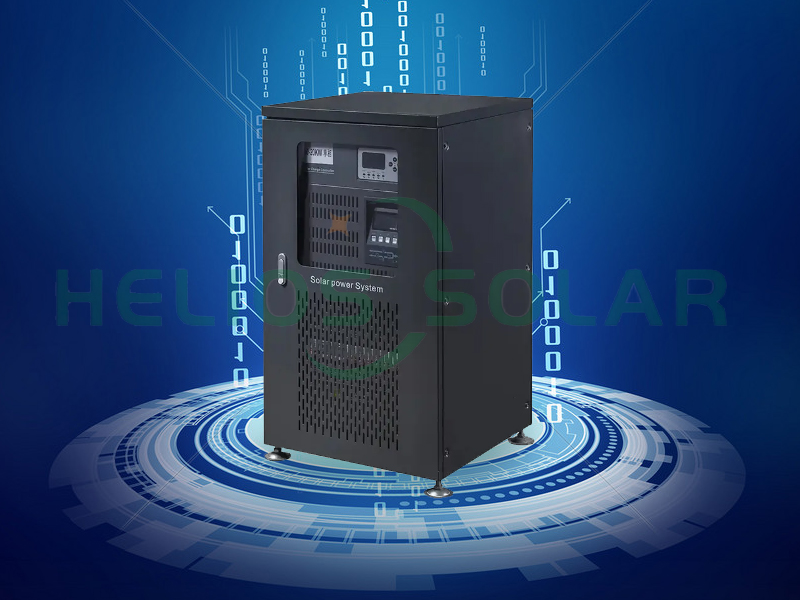As the world increasingly turns to renewable energy, solar energy has become a major contender in the search for sustainable energy solutions. At the heart of any solar power system is a key component: the solar inverter. This device is responsible for converting direct current (DC) generated by solar panels into alternating current (AC) that can be used by household appliances and fed into the grid. For anyone considering installing solar power, it is crucial to understand the different types of solar inverters. This article takes an in-depth look at the various types of solar inverters, their features, and their applications.
1. String inverter
Overview
String inverters, also known as central inverters, are the most common type of solar inverter used in residential and commercial solar power systems. They get their name from the way they connect a series of solar panels (a “string”) to a single inverter.
How they work
In a string inverter system, multiple solar panels are connected in series to form a string. The DC power produced by the panels is sent to the string inverter, which converts it into AC power. This alternating current is then used to power household appliances or fed into the grid.
Advantages
-Cost Effectiveness: String inverters are generally less expensive than other types of inverters.
-Easy: Due to their centralized nature, they are easier to install and maintain.
-Proven Technology: String inverters have been around for a long time and are a mature technology.
2. Microinverter
Overview
Microinverters are a relatively new technology compared to string inverters. Rather than a single inverter mounted on a series of panels, a microinverter is mounted on each individual solar panel.
How they work
Each microinverter converts DC power generated by its corresponding solar panel into AC power. This means that conversion occurs at the panel level rather than at a centralized point.
Advantages
-Optimized Performance: Since each panel operates independently, shadowing or malfunctioning of one panel will not affect other panels.
-Scalability: Microinverters offer greater flexibility in system design and are easier to expand.
-Enhanced Monitoring: They provide detailed performance data for each individual panel, allowing for better system monitoring and maintenance.
3. Power optimizer
Overview
Power optimizers are often used in conjunction with string inverters to enhance their performance. They are installed on each solar panel and are similar to microinverters, but they do not convert DC power to AC power. Instead, they optimize DC power before sending it to centralized string inverters.
How they work
Power optimizers regulate the DC power produced by each panel to ensure it operates at its maximum power point. This optimized DC power is then sent to a string inverter to be converted to AC power.
Advantages
-Improved Efficiency: Power Optimizer helps mitigate performance issues related to shadow and panel mismatch.
-Cost Effective: They offer many of the advantages of microinverters but at a lower cost.
-Enhanced Monitoring: Like microinverters, Power Optimizer provides detailed performance data for each panel.
4. Hybrid inverter
Overview
Hybrid inverters, also known as multi-mode inverters, are designed to work with solar panels and battery storage systems. They are becoming increasingly popular as more homeowners and businesses look to incorporate energy storage into their solar power systems.
How they work
A hybrid inverter converts DC power from solar panels into AC power for immediate use, stores excess energy in batteries, and draws energy from the batteries when needed. They can also manage the flow of electricity between solar panels, batteries and the grid.
Advantages
-Energy Independence: Hybrid inverters can use stored energy during periods of low solar generation or power outages.
-Grid Support: They can provide grid support functions such as frequency regulation and peak shaving.
-Future-proof: Hybrid inverters provide flexibility for future system expansion, including adding battery storage.
Conclusion
Choosing the right type of solar inverter is a critical decision that can significantly impact the performance, cost and flexibility of your solar power system. String inverters provide cost-effective and proven solutions for many applications, while microinverters and power optimizers provide enhanced performance and monitoring capabilities. Hybrid inverters are ideal for businesses looking to consolidate energy storage and achieve greater energy independence. By understanding the pros and cons of each type of solar inverter, you can make an informed decision that best meets your energy needs and goals.
Welcome to contact solar Inverters vendor Radiance for more information.
Post time: Sep-19-2024


